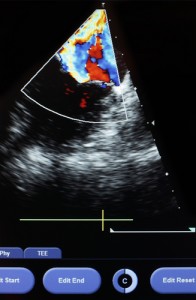Noninvasive Doppler Detects Pulmonary Hypertension

 Patients who show signs of pulmonary hypertension are reliably diagnosed non-invasively at the doctor’s office using Doppler echocardiography, a form of ultrasound. A group of researchers at the University of Heidelberg in Germany conducted a study of 1695 patients and determined that Doppler echocardiography reliably assessed systolic pulmonary artery pressure and agreed with diagnoses made via the standard method of right heart catheterization.
Patients who show signs of pulmonary hypertension are reliably diagnosed non-invasively at the doctor’s office using Doppler echocardiography, a form of ultrasound. A group of researchers at the University of Heidelberg in Germany conducted a study of 1695 patients and determined that Doppler echocardiography reliably assessed systolic pulmonary artery pressure and agreed with diagnoses made via the standard method of right heart catheterization.
The study, “Reliability of Noninvasive Assessment of Systolic Pulmonary Artery Pressure by Doppler Echocardiography Compared to Right Heart Catheterization: Analysis in a Large Patient Population,” was published in the Journal of the American Heart Association.
[adrotate group=”4″]
Estimation by Doppler resulted in an average systolic pulmonary artery pressure of 45.3 mmHg, while right heart catheterization measured an average pressure of 47.4 mmHg. The two measures were well correlated, and the same was true for measuring right atrial pressure by Doppler and right heart catheterization, with values of 12.1 mmHg and 12.0 mmHg, respectively.
Importantly, when the estimates were used to diagnose pulmonary hypertension, the method was sensitive and specific, with a sensitivity of 87% and a specificity of 79%. These figures bolster the recommendation of using Doppler echocardiography as a means for detecting pulmonary hypertension non-invasively. The study is meaningful, as “noninvasive quantification of systolic pulmonary arterial pressure has never been tested sufficiently in unselected large patient populations undergoing routine echocardiography examination,” wrote the authors. Considering that pulmonary hypertension is a disease that is often manifested as a complication of other diseases, such as Idiopathic Pulmonary Fibrosis and Scleroderma, these new diagnostic insights into detecting PH are crucial to administering early and accurate diagnoses.
[adrotate group=”3″]







